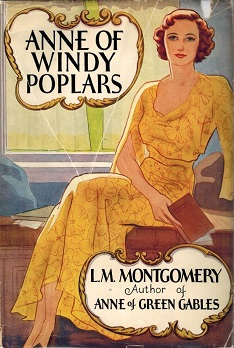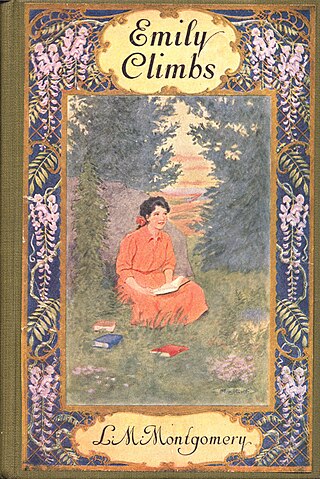Plot summary
Valancy is, at twenty-nine, the old maid of the Stirling clan, which is a reputable family that has lived in the same region for over fifty years. As an only child, her entire life has been spent with her nagging mother, her perpetually down-trodden aunt, and a gossipy extended family, who, in spirit of the Victorian and middle class, actively discourage happiness and treat Valancy like a child, telling her what to do every day and constantly comparing her with her beautiful cousin, Olive, putting her down, and calling her by the baby name "Doss." Her only respites come from daydreaming of her "Blue Castle" and the handsome men who would reside in it with her, along with reading the nature books of John Foster.
Valancy is shockingly diagnosed with a fatal heart ailment when she goes in for a checkup, a fact she keeps secret from all of her family, as she went to a doctor that isn't considered the 'right' one, because the family has a long-lived feud with his family.
Believing she has very little time left to live, she decides to break free from the oppressive constrains, expectations, and obligations her ever-judging family has laid on her since birth. She has always judged them objectively and secretly laughed at their hypocrisy, self-righteousness, and greed but now she decides that she shouldn't let her ever-judging relatives stop her from having a chance to 'live' by letting everyone know what she thinks of them and their everyday, strife-filled actions. She starts saying aloud what she thinks of them, causing the Stirlings to conclude that she has suddenly gone 'dippy' and that they must somehow 'fix' her through prayer for her soul, guilting her, and pretending that what she does won't make them think that she is a heretic.
Valancy then scandalizes the clan even more by moving out of her mother's house and taking a position as a housekeeper for her very ill childhood friend Cissy Gay and her father, who is a master carpenter and notorious town drunk named Roaring Abel. Cissy is dying of consumption, but is socially ostracized for having had a child out of wedlock one summer, although the child died soon after being born, and since then Cissy has wasted away from her sickness and the perpetual misery of losing her beloved baby. Cissy and Valancy share a room and renew their friendship. Valancy enjoys earning a salary and spending her money in ways her family would not approve of – such as purchasing a brightly-coloured, low-necked dress. But her real satisfaction comes from doing something worthwhile, and doing it well. She also meets and spends time with Barney Snaith, who is a good friend of both Abel and Cissy, but whom town gossips are convinced is a criminal in hiding, a horrible drunk like Roaring Abel, and/or the father of Cissy's illegitimate, now-deceased child.
Towards the end Cissy confides in Valancy, telling her about the man she fell in love with but refused to marry because he no longer loved her. Her baby compensated for her heartache, but when the infant died she was devastated. Cissy passes away quietly and Valancy makes all the funeral arrangements, setting the house in order for Abel before leaving.
All this time Stirling prestige has suffered from Valancy's actions, her 'going into service' and associating with 'lowlifes,' and several unsuccessful attempts are made to have her come 'home.' Now they assume she will move back to live with her mother and aunt, having magnanimously decided to forgive her recent behaviour and gloss over it as an act of 'Christian charity'. They are appeased after the funeral when Valancy agrees that she will not stay with Roaring Abel - unaware that she has other plans. She proposes marriage to Barney, revealing that she is dying and wants to enjoy the remaining time she has left. She does not confess her love for him, instead telling him that she is 'crazy about him' and that it's one of the reasons why she picked him as a potential husband. Barney agrees to marry her, and they have a quiet ceremony the next day in the next town over. Valancy's family, who found a good match for her while she was housekeeping, are horrified by her marriage to such a 'disreputable' man (whose real crime is being unconventional and not being related to a 'good family' from the area) and effectively disown her.
Barney takes Valancy to his home on a wooded island located on Lake 'Mistawis,' which Valancy sees as the 'Blue Castle' of her imaginings. They build a contented life together, though he forbids her from ever entering a certain room which she dubs 'Bluebeard's Chamber', claiming that he could have multiple wives strung up on the walls by their hairs. Barney and Valancy share wonderful conversations and take long walks on the mainland, she often quoting from books by John Foster, which he abhors and refuses to listen to. They celebrate Christmas, he giving her the only gift she asked for: a necklace of pearl beads.
Valancy also takes the time to exorcise old demons, building a large sand pile to make up for one that her cousin Olive had stolen from her when they were in grade school. Also, while Valacy is collecting moss and flowers to decorate their cabin, she comes upon Allan Tierney, a celebrated painter of beautiful women, who, when he sees her, hastens to find Barney and asks to paint her portrait, which he declines. Valancy agrees with his decision, although she wishes that Olive, her snooty cousin, would hear that Allan Tierney wanted to paint her.
The year she had to live is almost over when Valancy is nearly killed by an oncoming train, her fancy, heeled shoe caught in a train track. Barney saves her in the nick of time, risking his own life to do so. After the shock passes, Valancy realizes that she should have died of it: the doctor warned that any sudden shock would kill her. Barney is likewise stunned by the experience and retreats to his beloved woods and Bluebeard's Chamber to think. Valancy assumes that he has left because, having married her out of pity, he now realizes he is trapped in a marriage he doesn't desire.
Valancy returns to the doctor, who discovers that he sent Valancy "Stirling" a letter with a diagnosis meant for Miss "Sterling," an elderly, spinster patient who visited him on the same day and had a fatal heart condition; Valancy's letter went to her instead. While equally painful, Valancy's condition was temporary and could be healed from a sudden jolt of happiness, sadness, or adrenaline.
Arriving home from the doctor depressed, with Barney still away, she finds a gaudily dressed man waiting near their home. He introduces himself as Barney's father, Dr. Redfern, the multi-millionaire inventor of Dr. Redfern's patent medicines. Dr. Redfern explains that a decade earlier Bernard Snaith Redfern abruptly left home without a word, having dumped his girlfriend he thought loved him who he found out was a gold-digger. Dr. Redfern had no idea where his son was (as Barney was constantly traveling and only sent a few postcards) until Barney withdrew $15,000 (+/-$226,000 in 2023) from his bank account to purchase a pearl necklace from a reputable jewelry house. Dr. Redfern is an overall genial man, and although sad that he wasn't invited the wedding, is pleased that Barney has settled down and asks that Barney come home as he is the only family he has.
Thinking that Barney believes she tricked him into marriage and that he still loves his ex-girlfriend, Valancy decides to leave him and return to her mother's house. While searching for pen and paper to write Barney an explanatory note, she unthinkingly goes into 'Bluebeard's Chamber' and discovers that he is also 'John Foster,' her favourite author that he refused to listen to and bad-mouthed repeatedly. She writes the note, explaining the mix-up behind her diagnosis and asking for a divorce, knowing now that he can afford it and leaves behind the necklace, which she had thought an expensive imitation.
Valancy returns home despondent and reveals to her family that Barney is the son of famous and wealthy Dr. Redfern, as well as the noted literary figure John Foster. Barney's wealth instantly erases any misgivings her family had about him, and they are determined that Barney and Valancy should stay together, and her wealthy uncle, Benjamin, knowing now that she has married a millionaire's son, therefore redeeming herself, un-disowns her.
Barney, after meeting his father, finds Valancy's note and rushes to town to see her and ask her to come back. Barney's absence after the train incident was due to the stunned realization that he had grown to love her so much, he would not want to live without her and so he was contemplating contacting his father for the first time in a decade to ask for money to pay for expensive medical treatments that could somehow heal her. At first she refuses, believing that he is only asking out of pity, but when he becomes angry, thinking she is ashamed of his father's patent medicine business just like his ex-girlfriend was, she realizes he does love her and agrees to return.
Barney reconciles with his father but will not live with him; they will build a home of their own out in the country, but near enough to visit. Meanwhile Barney and Valancy prepare to go on the honeymoon they never had, albeit extended and while touring Europe, knowing their summer home on Barney's small island - her 'Blue Castle' - will be waiting for them.
In a post-credit-like page, Olive is writing to her fiancee, Cecil Bruce, telling him about Valancy getting married to Barney and how they found out he was a millionaire in his own right, and how now every single relative is positively fawning over the couple. In an almost jealous diatribe, she wonders why some people can make their entire lives an utter mess with their adventures and yet end up married to a rich person, and she says that if this is what happens when someone runs away and flouts family expectations, then what is the use in behaving?


















